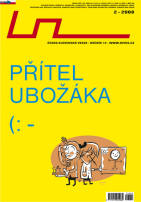| Umělec 2008/2 >> Takako Kimura | Просмотр всех номеров | ||||||||||||
|
|||||||||||||
Takako KimuraUmělec 2008/201.02.2008 Spunk Seipel | stickers | en cs de es |
|||||||||||||
|
Stickers! Sticky pictures! Little stickies! Several years ago, an entire industry sprang up to offer children—primarily girls, understandably—countless images placed on tiny, moderately small, and sometimes even notably larger stickers. In themselves, these stickers have no value whatever: kitsch-pictures, the same sort as the pictures that young collectors once scraped off of the papers stuck inside of chocolate bars.
Only the albums that have been developed for this strange hobby come close to explaining the popularity of this new “sticker generation”. In other words, these blank notebooks made from special paper allowing the stickers to be peeled off and exchanged for others. Takako Kimura, a Japanese-born artist now living in Munich, makes use of these same stickers in her latest works, creating new images with a notably ironic undertone. Using hundreds of stickers, she pieces together collages that present an “enlarged” version of what the individual stickers represent. One of her images of a ladybug, for example, consists of dozens of ladybug-stickers of differing size, form and colour. And so the stickers, originally made to stand alone, to be observed as individual objects, now are competing for the notice of the observer. In a sense, they lose their individuality, almost completely obliterated by other stickers, and now only part of a mass that forms a much greater whole through their mutual interplay. For Kimura, it holds up a mirror to human society, in which the individuals together form a single common picture, lose themselves and hence create something much greater. One can view this artwork in such a way: it is one interpretive possibility, and has its own charm. Particularly, it holds for the newest works, in which no longer is only one figure depicted, but instead several figures beside one another, pieced together from hundreds of stickers, presenting an entire story. It is equally possible to enjoy simply its artistic aspects: the optical effects, the play of merging and differentiated shapes and colours. To watch, from these individual pictures, more and more new pictures emerge. Does this not recall Giuseppe Arcimboldo and his assemblage-portraits? Is this artist, born in 1974, not creating them again in a new, current, contemporary form? A variant that makes use of the sub-images of our pop-culture? Is this game not an endless source of pleasure for our eyes, if in the midst of the search for separate stickers – whether particularly beautiful or particularly repulsive – the image flicks back to the much larger picture, in which the individual counts for nothing? And yet there is also a certain degree of irritation, turning perhaps into a sense of insecurity from viewing these pictures: we are not looking into one pair of eyes alone, but instead countless eyes are staring back at us. These artworks are presented under glass, as if they were the collection-pieces of a fanatical lepidopterist. It raises the character of the objects and grants the images, or their materiality, the stiffness of a panel-painting. Yet all the while, an atavistic lust for the hunting and collection of especially beautiful stickers, remains alive. So this is how the artist seems to have, in spite of everything, preserved the fun that all children have in collecting these bright stickers. She searches out and finds the most exceptional stickers, and we see in her work the joy of making the stickers into new images.
01.02.2008
Рекомендуемые статьи
|
|||||||||||||









Комментарии
Статья не была прокомментированаДобавить новый комментарий